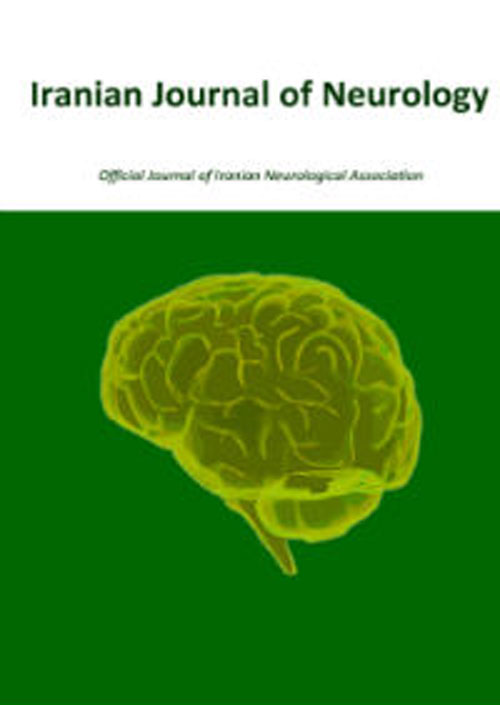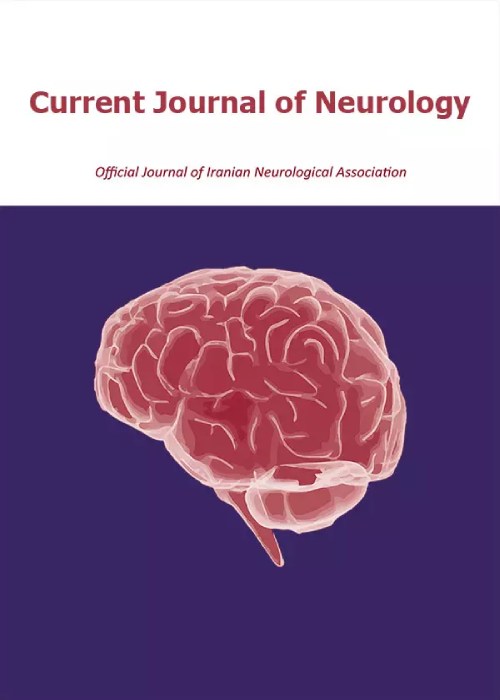فهرست مطالب

Current Journal of Neurology
Volume:15 Issue: 1, Winter 2016
- تاریخ انتشار: 1394/12/04
- تعداد عناوین: 10
-
-
Pages 1-8BackgroundHeadaches are one of the most frequent reasons for pain in multiple sclerosis (MS) individuals. Characterization of headaches and delineating possible relationships with MS-related determinants can ultimately circumvent headaches.MethodsIn a prospective case-control study, 65 Iranian relapsing- remitting MS (RRMS) patients and 65 healthy controls were recruited during patients’ admission for attack-period treatment and asked about characteristics and co-symptoms of headaches they experienced in the preceding week and usage of disease modifying drugs (DMDs) and types of MS attacks were also inquired. The same questions were asked from the same patients 3 months later in a follow-up visit.ResultsA total of 57 patients and 57 controls were included in the final analyses. In total, 26 (45.6%) patients in relapse, 18 (27.7%) controls, and 22 (38.6%) patients in remission reported headaches and only significant difference existed between relapse patients and controls (P = 0.036). In headache prevalence was higher in patients in relapse phase having MS < 3 years compared to relapse patients with more than 3 years of MS (68 vs. 28.1%; P = 0.004). Other variables of interest did not differ among the three groups.ConclusionThe RRMS patients in relapse phase suffer from headaches more than healthy people do.Keywords: Multiple Sclerosis, Headache, Relapse, Remission, Case, Control Studies
-
Pages 9-15BackgroundFew investigators have reported case fatality and disability of Iranian patients with stroke. This study was designed to collect morbidity and case fatality data of hospitalized patients with stroke, and stroke care quality in Isfahan, Iran.MethodsFrom 2006 to 2011, from overlapping sources (discharge diagnoses, attending physicians, and hospitalization wards), all hospitalized patients with possible strokes were enrolled in the study, their hospital records were summarized by experienced personnel and reviewed by a neurologist with stroke experience. Patients were followed by phone calls or visited to their addresses and their 28th day functional status was checked by translated modified Rankin Scale (mRS). Forms and methods were derived from the World Health Organization (WHO) Monitoring Trends and Determinants in Cardiovascular Disease and STEPS projects.ResultsA total of 9487 patients were identified to suffer from stroke. Their ages’ mean was 68.98 ± 13.63 years, and 50.0% were females. In hospital, case fatality was 16.5% and the 28th day case fatality was 25.6%. The greatest case fatality was among intracerebral hemorrhage (ICH) patients and the least among ischemic stroke (IS) ones. Case fatality was greater among female and older patients and those with the previous history of stroke. Among survivors, only 26.9% were functionally independent (mRS < 3) which was the greatest among subarachnoid hemorrhage (SAH) patients and least among ICH patients. None of the patients were admitted to specific stroke units or received thrombolytic therapy.ConclusionThe hospitalized patients with stroke in Isfahan have unfavorable outcome compared with their mates in developed countries. A low quality of stroke care may be responsible, and urgent attention is needed.Keywords: Stroke, Case Fatality Rate, Disability Evaluation, Epidemiology, Risk Factors
-
Pages 16-22BackgroundCognitive impairment in patients with Parkinson’s disease (PD) mainly involves executive function (EF). The frontal assessment battery (FAB) is an efficient tool for the assessment of EFs. The aims of this study were to determine the validity and reliability of the psychometric properties of the Persian version of FAB and assess its correlation with formal measures of EFs to provide normative data for the Persian version of FAB in patients with PD.MethodsThe study recruited 149 healthy participants and 49 patients with idiopathic PD. In PD patients, FAB results were compared to their performance on EF tests. Reliability analysis involved test-retest reliability and internal consistency, whereas validity analysis involved convergent validity approach. FAB scores compared in normal controls and in PD patients matched for age, education, and Mini-Mental State Examination (MMSE) score.ResultsIn PD patients, FAB scores were significantly decreased compared to normal controls, and correlated with Stroop test and Wisconsin Card Sorting Test (WCST). In healthy subjects, FAB scores varied according to the age, education, and MMSE. In the FAB subtest analysis, the performances of PD patients were worse than the healthy participants on similarities, fluency tasks, and Luria’s motor series.ConclusionsPersian version of FAB could be used as a reliable scale for the assessment of frontal lobe functions in Iranian patients with PD. Furthermore, normative data provided for the Persian version of this test improve the accuracy and confidence in the clinical application of the FAB.Keywords: Executive Function, Parkinson's Disease, Frontal Assessment Battery
-
Pages 23-27BackgroundTo determine whether Islamic fasting would change cerebral blood flow during Ramadan.MethodsThe study group comprised 20 subjects (16 males and 4 females) on a regimen of 1 month food and water intake restriction, according to Islamic fasting ritual. Subjects were evaluated for cerebral bolo flow through a middle cerebral artery (MCA) by means of transcranial Doppler (TCD), the day before starting Ramadan fasting and the day after the month of Ramadan.ResultsOur results showed no statistically significant changes after Ramadan in cerebrovascular hemodynamic, in comparison before Ramadan.ConclusionAlthough some studies showed metabolic changes during Ramadan fasting (increasing hematocrite, decreasing amount of hemoglobin, dehydration, platelet aggregation, and lipid profile alternations) the findings suggest that Islamic fasting has no significant effects on cerebral blood flow.Keywords: Fasting, Cerebrovascular Circulation, Transcranial Doppler, ýBlood Flow Velocity
-
Pages 28-33BackgroundCerebrovascular disease leading to stroke is the most common cause of aphasia. Speakers with agrammatic non-fluent aphasia have difficulties in production of movement-derived sentences such as passive sentences, topicalized constituents, and Wh-questions. To assess the production of complex sentences, some passive, topicalized and focused sentences were designed for patients with non-fluent Persian aphasic. Afterwards, patients’ performance in sentence production was tested and compared with healthy non-damaged subjects.MethodsIn this cross sectional study, a task was designed to assess the different types of sentences (active, passive, topicalized and focused) adapted to Persian structures. Seven Persian patients with post-stroke non-fluent agrammatic aphasia (5 men and 2 women) and seven healthy non-damaged subjects participated in this study. The computed tomography (CT) scan or magnetic resonance imaging (MRI) showed that all the patients had a single left hemisphere lesion involved middle cerebral artery (MCA), Broca`s area and in its white matter. In addition, based on Bedside version of Persian Western Aphasia Battery (P-WAB-1), all of them were diagnosed with moderate Broca aphasia. Then, the production task of Persian complex sentences was administered.ResultsThere was a significant difference between four types of sentences in patients with aphasia [Degree of freedom (df) = 3, P < 0.001]. All the patients showed worse performance than the healthy participants in all the four types of sentence production (P < 0.050).ConclusionIn general, it is concluded that topicalized and focused sentences as non-canonical complex sentences in Persian are very difficult to produce for patients with agrammatic non-fluent aphasia. It seems that sentences with A-movement are simpler for the patients than sentences involving A`-movement; since they include shorter movements in compare to topicalized and focused sentences.Keywords: Stroke, Nonfluent Aphasia, Agrammatism, Production, Sentence
-
Pages 34-45BackgroundSubthalamic nucleus (STN) stimulation is the reatment of choice for carefully chosen patients with idiopathic Parkinson's disease (PD) and refractory motor fluctuations. We evaluated the value of intraoperative electrophysiology during STN deep brain stimulation (DBS) procedures in refining the anatomically-defined target.MethodsWe determined the spatial distance between the anatomical and physiological targets along x, y and z axes in 50 patients with PD who underwent bilateral subthalamic nucleus DBS surgery.ResultsThe mean spatial distance between anatomical and functional targets was 1.84 ± 0.88 mm and the least distances in different methods were 0.66 mm [standard error (SE): 0.07], 1.07 mm (SE: 0.08) and 1.01 mm (SE: 0.08) on x, y and z axes, respectively, for the combined method.ConclusionThe most physiologically-accurate anatomical targeting was achieved via a combination of multiple independent methods. There was a statistically significant difference between the anatomical and functional targets in all methods (even the combined) on the y coordinate, emphasizing the need for intra- operative electrophysiological monitoring to refine the anatomico-radiologically-defined target.Keywords: Parkinson's Disease, Deep Brain Stimulation, Intraoperative Monitoring, Micro, electrode ýRecording
-
Pages 46-53The myotonic disorders are a heterogeneous group of genetically determined diseases that are unified by the presence of myotonia, which is defined as failure of muscle relaxation after activation. The presentation of these disorders can range from asymptomatic electrical myotonia, as seen in some forms of myotonia congenita (MC), to severe disability with muscle weakness, cardiac conduction defects, and other systemic features as in myotonic dystrophy type I (DM1). In this review, we describe the clinical features and pathophysiology of the different myotonic disorders, their laboratory and electrophysiologic findings and briefly review the currently available treatments.Keywords: Myotonia, Myotonic Dystrophy, Myotonia Congenita, Paralysis Periodica Paramyotonia, ýHyperkalemic Periodic Paralysis
-
Pages 60-61


